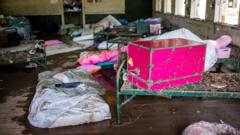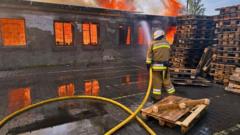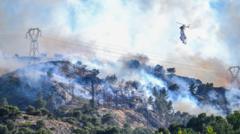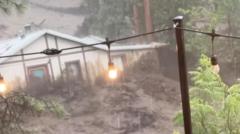Authorities report extensive damages, as the historical landscape is altered and cultural relics are threatened.
**Tragic Wildfires in South Korea Claim 24 Lives, Evacuate Thousands**
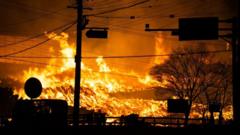
**Tragic Wildfires in South Korea Claim 24 Lives, Evacuate Thousands**
Unprecedented wildfires in South Korea’s southeast region led to numerous fatalities and widespread destruction.
The devastating wildfires that broke out in South Korea's southeast have claimed at least 24 lives, primarily among the elderly, with many victims aged between 60 and 70. As emergency services battle the flames, authorities confirm that around 26 individuals are injured, 12 critically. More than 23,000 residents have been forced to evacuate their homes amidst this calamitous event, which has been described as rewriting the record books for wildfires in the nation.
Acting President Han Duck-soo referred to the ongoing crisis as "unprecedented," highlighting that the wildfires have obliterated numerous areas, including a revered 1,300-year-old temple in Uiseong city. As the situation rapidly escalated, fires initially ignited in Sancheong county on Friday and quickly spread, driven by fierce winds, to several neighboring counties including Gyeongbuk and Andong.
In a tragic turn, a firefighting helicopter crashed in the mountains of Uiseong, resulting in the pilot's death. Thousands of firefighters, alongside 5,000 military personnel and additional support from U.S. helicopters stationed in Korea, are tirelessly working to control the flames. Reports indicate that approximately 17,000 hectares (42,000 acres) of forests have been irreversibly damaged, noting that these fires are among the deadliest and most expansive in South Korea's history.
Local residents shared their devastating experiences. One villager in Andong lamented the total loss of their home, stating, "It was almost completely collapsed." A 30-year-old man in Uiseong expressed the heartache of watching his neighborhood, filled with elders who have lived their whole lives there, turn to ash. The fire also caused significant historic losses, including the destruction of Gounsa temple, built in 618 AD, and other national treasures from the Joseon Dynasty.
Witnessing the catastrophe invoke comparisons to apocalyptic scenarios, one truck driver remarked on the devastating sight as he drove through the burning mountains. While the government hopes for rain to aid firefighting efforts, forecasts predict minimal precipitation. In response to the rising tragedies, officials have vowed to enhance enforcement against illegal burning practices, which are a significant cause of wildfires, while addressing issues of negligence.
The country has faced an alarming increase in wildfire incidents this year, with 244 reported fires, significantly surpassing the figures of last year. As the battle against the flames continues, the community comes together, determined to rebuild in the aftermath of this crisis.
Acting President Han Duck-soo referred to the ongoing crisis as "unprecedented," highlighting that the wildfires have obliterated numerous areas, including a revered 1,300-year-old temple in Uiseong city. As the situation rapidly escalated, fires initially ignited in Sancheong county on Friday and quickly spread, driven by fierce winds, to several neighboring counties including Gyeongbuk and Andong.
In a tragic turn, a firefighting helicopter crashed in the mountains of Uiseong, resulting in the pilot's death. Thousands of firefighters, alongside 5,000 military personnel and additional support from U.S. helicopters stationed in Korea, are tirelessly working to control the flames. Reports indicate that approximately 17,000 hectares (42,000 acres) of forests have been irreversibly damaged, noting that these fires are among the deadliest and most expansive in South Korea's history.
Local residents shared their devastating experiences. One villager in Andong lamented the total loss of their home, stating, "It was almost completely collapsed." A 30-year-old man in Uiseong expressed the heartache of watching his neighborhood, filled with elders who have lived their whole lives there, turn to ash. The fire also caused significant historic losses, including the destruction of Gounsa temple, built in 618 AD, and other national treasures from the Joseon Dynasty.
Witnessing the catastrophe invoke comparisons to apocalyptic scenarios, one truck driver remarked on the devastating sight as he drove through the burning mountains. While the government hopes for rain to aid firefighting efforts, forecasts predict minimal precipitation. In response to the rising tragedies, officials have vowed to enhance enforcement against illegal burning practices, which are a significant cause of wildfires, while addressing issues of negligence.
The country has faced an alarming increase in wildfire incidents this year, with 244 reported fires, significantly surpassing the figures of last year. As the battle against the flames continues, the community comes together, determined to rebuild in the aftermath of this crisis.

